Prescription Glasses: From Then to Now
2 September 2019 | Admin
Prescription glasses are such an everyday item in today’s world that it can be hard to imagine a time when prescription glasses didn’t exist! The progression of glasses has been slow and certainly not clear-cut in the way many other inventions are known about with a fixed year of invention and a known inventor.
One of the most intriguing things we found when we researched the history of glasses was that often it’s paintings that provide the most conclusive evidence of the existence of glasses at a particular time period.
THE EARLY DAYS OF GLASSES
The Roman philosopher, Seneca, who lived 2 millennia ago, was said to have used a glass globe of water to magnify text and read books - perhaps the earliest recorded mention of a way to use a lens to help with sight. Monks of the Middle Ages were documented to have used glass spheres, known as ‘reading stones’ to read text, essentially a magnifying glass held over text to enlarge it.
| Around 1000AD, these reading stones started to become more popular but it wasn’t until the late 13th century, in Italy, that
Venetian glass-blowers added two of these ‘magnifying lenses’ to a frame made of wood or bone or animal horn or iron. The
frame could then be rested on the nose for reading, helped by a rivet that gripped the nose so they couldn’t fall off too easily.
The first known prescription glasses.
No one knows for certain whether it was the glass-blowers themselves, or, perhaps more likely, scholarly monks or the
superintendents of Venetian Arts who had the actual idea to combine the two.
Opposite is a painting from 1352 by Tomasso da Modena of Cardinal Hugh de Provence. It’s the first known painting that
depicts someone wearing glasses. Notice that his head is positioned quite far forward but the glasses are staying on the nose.
How well they stayed on is a matter of contention!
Over the centuries (and still to this day) it became a challenge to find the best and most comfortable way for the glasses to stay
on the head. Notable is that there were no sides (otherwise known as temples or arms). These weren't to come until much
later. | 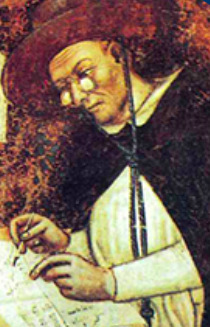 |
FIRST GLASSES FOR DISTANCE RATHER THAN FOR READING
So far, glasses were only for those who needed them for reading. With the advent of the printing press in the 15th century and consequently books, reading started to become a more popular pastime. Gradually reading glasses would have become more and more well-known in the wider public consciousness throughout the 1400's & 1500's. It wasn’t until the early 16th century that we see evidence of glasses used for distance - for those who are shortsighted (otherwise known as nearsighted).
The detailed painting below by Raphael in the year 1517 depicts Pope Leo X. Notice in his hands, he has a single lens. Because we can see through the lens, we know it to be a concave lens, used to treat myopia (shortsightedness). Indeed, the Pope’s family was famously nearsighted and the Pope himself used his glasses for hunting; he wrote the words: ‘With them I see better than my companions’, in relation to hunting.
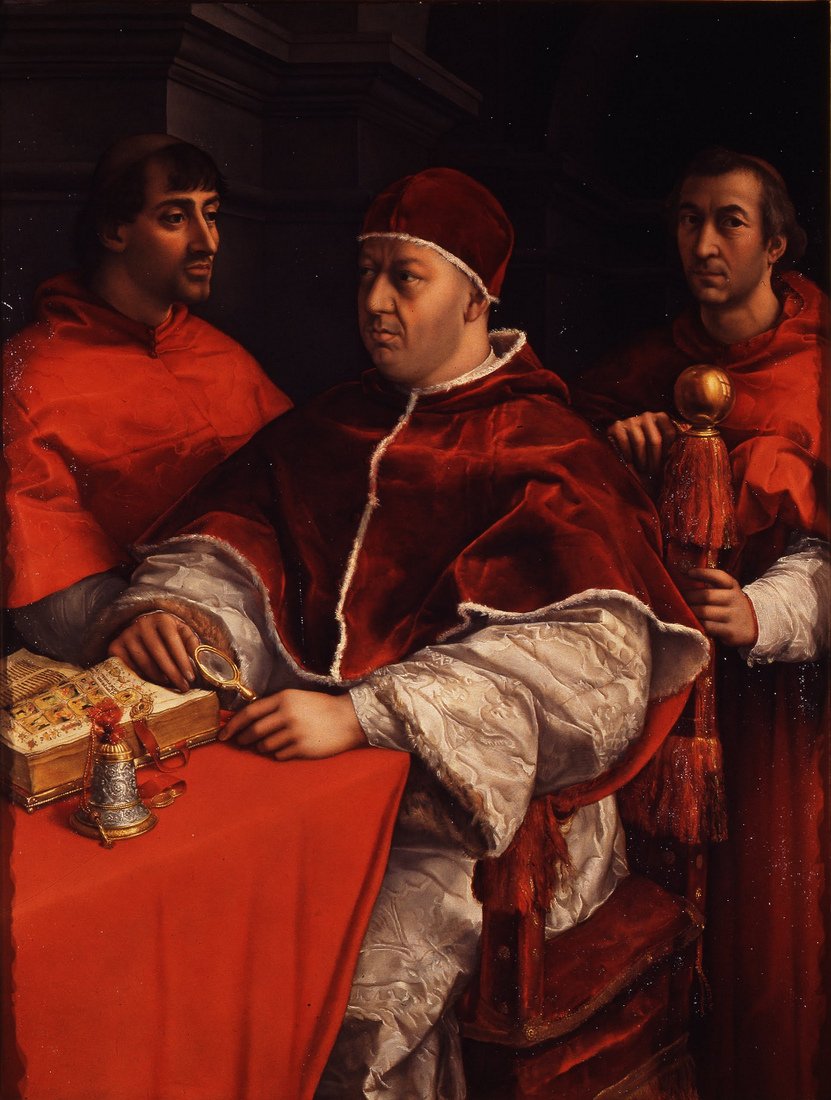
THE SIDES (otherwise known as ARMS or TEMPLES) ARE ADDED
It wasn’t until about 300 years ago, some time before the year 1730, that the sides to the glasses were thought of and so start to look like the prescription glasses we think of today. Again, no one is sure who is accredited with being the first; some suggest is was an optician from London by the name of Edward Scarlett although he may have just been the first to advertise and sell them.
The glasses style though was still quite unusual compared to what we’re used to today. Some were were held in place by the back of the head, helped by the hair wigs that were popular at the time.
Others had fairly large circles at the end of the arms with which a cord could go through and the wearer could let them hang from their neck when not being worn. They look as if they may struggle to stay on the face but they would be able to rest on
the ears, although it may not have been advised to tilt the head too far forward; the cord could then come to the rescue!
(Opposite is a pair of prescription glasses with unusual temples that fit at the back of the head rather than behind the ears). | 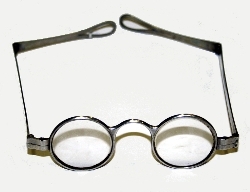 |
There was probably the thought also that they would also be used to wear with a wig to hold them in place better. It was thought that the large holes were designed so that wearers could casually hold them through a finger when not being used! Pictured below is a pair of Martin's Margins spectacles that were popular for more than 100 years during the 18th & 19th centuries. They're shown from different angles. We love the picture of them with their arms closed; images are invoked of a householder retiring for the night, folding the glasses and resting them gently on a table!
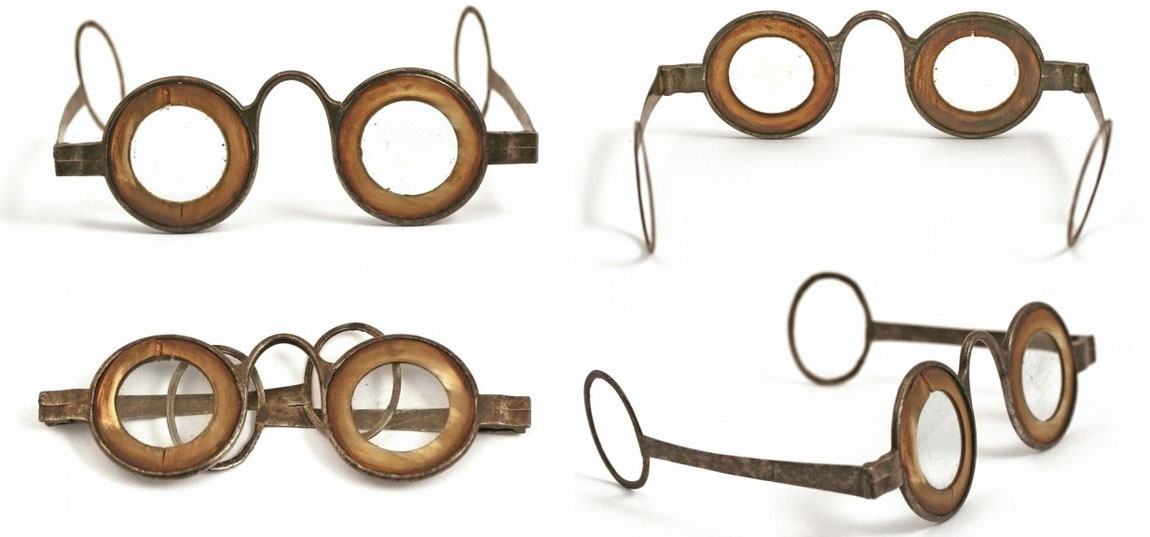
It’s interesting to speculate as to whether it was the introduction and popularity of newspapers at this time that drove the invention of the arms as more and more people were reading. It can be surprising to learn that the temples were only invented 300 years ago but if there wasn’t really a huge demand for them, it becomes more understandable. Although the printing press had helped lower the cost of books considerably, the first books were in Latin and it was a very slow process for books to begin being printed in local languages. As, is thought, there were not vast numbers of people who were reading prior to the 18th century, then there may well have not been that necessity that helps spur innovation & invention.
Prescription glasses for distance though had been around since at least the early 16th century. There is thought that people who were nearsighted (needing distance glasses) weren’t seen as needing correction as they could concentrate on jobs that required detailed attention, such as stonemasonry. It is thought employers valued those with nearsighted vision highly as they were less likely to decide on a career change because there were fewer job options for them. With the long job training that these jobs entailed, the employer really didn’t want to lose an employee that they’d invested so much time in!
EYE TESTS & THE BEGINNING OF MODERN OPTICS
Prescription glasses with sides became the norm in the 18th century but it wasn’t until the early 19th century that patients had an eye test for their prescription. Before then, they would choose their glasses by trial and error by trying on lots of different prescription glasses with different lenses and deciding themselves which work best. Often, optical salesman in horse and cart would travel directly to peoples homes, although more and more optical stores were opening also. You could say that it’s gone full circle as we now post our glasses out to customers without them visiting us, although the Royal Mail is a tad quicker than using a horse!
It wasn’t until the 1860’s that the standard eye chart with large letters at the top was used. The 19th century saw a huge increase in the number of people wearing prescription glasses, mainly because of the mass production that was now possible due to the industrial revolution. Whereas previously, prescription glasses were generally too expensive for the majority, they were now abundant and inexpensive and the masses benefited. There were ever increasing designs too and the side arms that fit snuggly behind the ear and that we’re so used to today were becoming popular.
THE 20TH CENTURY & BEYOND: PLASTICS, SUPRAS, TITANIUM & FASHION
The mid-20th century saw a huge change in prescription glasses with the invention of plastic. Prescription glasses could now be easily moulded in an infinite variety of ways. Glasses were changing from the utilitarian, functional nature of the past to one of fashion. Being so prominent on the face, it seems an inevitable progression that prescription glasses would begin to make an important fashion statement, such that people who didn’t need any vision correction started wearing them!
The mid-20th century also saw the creation of semi-rimless glasses, known as 'supra' glasses. Having no frame rim in the bottom half of the frame front was an innovative design that continues to be a popular choice to this day. Many wearers feel their vision is opened up, without the hindrance of a bottom rim. Below is one of the popular supra frames that we have on the website, our Radley 'Zoe' prescription glasses (colour Matt Bronze / Blue, 003):
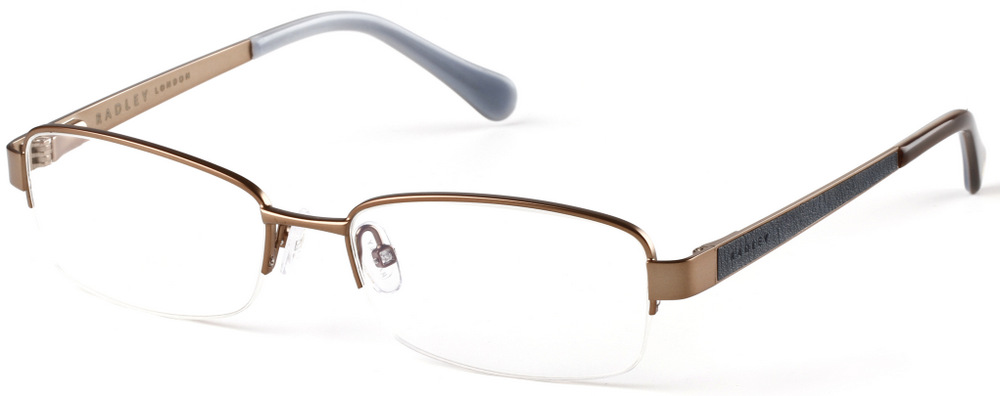
Iconic celebrities such as Buddy Holly in the 1950’s, with his black horn-rimmed, plastic glasses and John Lennon in the 1970’s with his small round metal glasses helped make glasses cool.
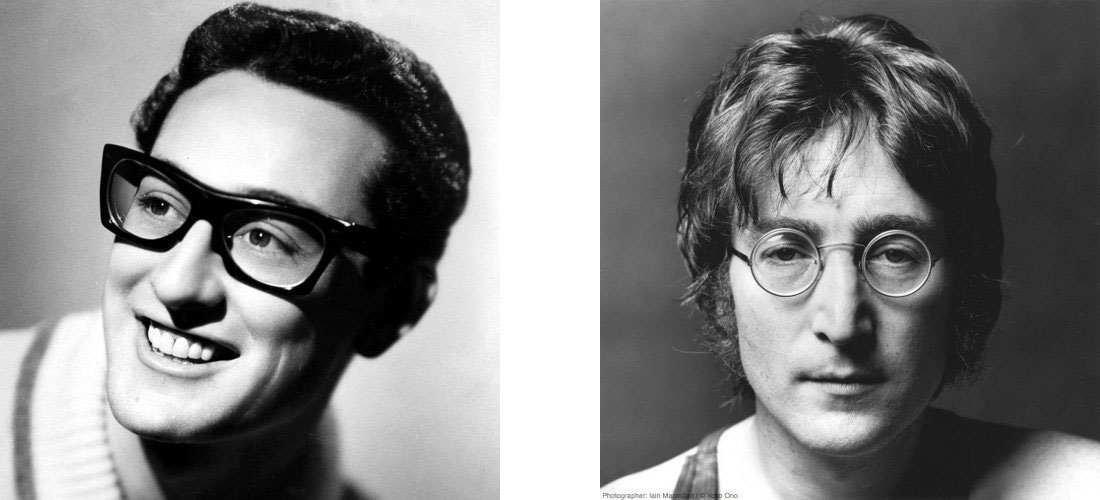
Global fashion houses took note and the 70’s and 80’s saw the start of world-renowned brands branch out into developing and styling glasses. The 80’s also saw plastic lenses take over from the previous glass. Glass was heavy, particularly if someone had a high prescription. Plastic could be made much more lightweight and thinner. There were also much safer as there was a risk of glass shattering - not something that you want to happen near your eye. For that reason, lens manufacturers and optometrists are now very wary of making and selling prescription glasses made with glass lenses, perhaps understandably so with today’s insurance/compensation culture.
If you browse our website, you'll see the wide variety of prescription glasses that you're able to purchase. With over 50 different brands and more than a thousand different frame models, from Police glasses to Superdry glasses, Jaguar glasses, Nina Ricci glasses, Barbour glasses, Radley glasses & O'Neill glasses, there's a lot of choice in terms of the style, size and material used.
A big trend in recent years has been titanium glasses. Titanium metal is lightweight yet very strong and extremely resistant to corrosion. The aerospace, automobile & medical industries love the properties of titanium and so use it extensively. It also makes a great fit for prescription glasses, although it does cost more than regular stainless steel metal. Below are our sleek Police VPL 685 'Blackbird TI 3' titanium prescription glasses (colour Matt Gunmetal, 0627):
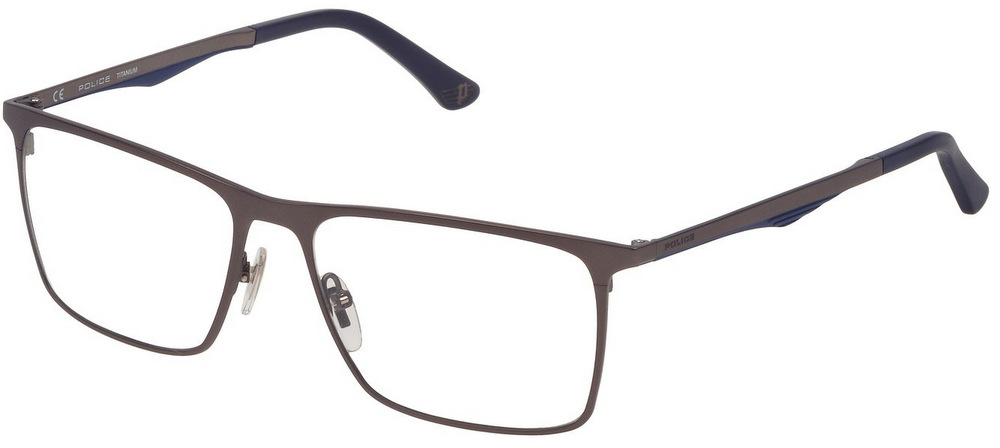
Another cool recent trend has been wood. The first 'glasses' way back in the 13th century used wood. Nowadays, manufacturers tend to prefer to just have wooden sides rather than the whole frame as it's strength isn't that of metals. The wooden sides create a striking effect that may turn heads! Below are our bold O'Neill 'Daize' prescription glasses (colour Matt Black, 104):
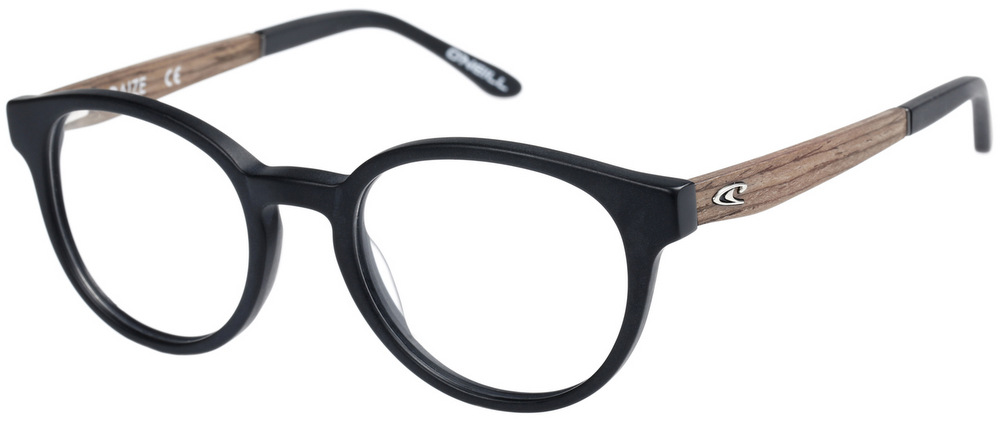
A popular style trend that has lasted for decades is combining the two materials of metal and plastic such that a frame may have a plastic front and metal sides, or a metal front with plastic sides (and often a plastic & metal front with plastic & metal sides!). Below is a popular frame of ours that demonstrates this well, with it's stylish plastic (acetate) front and sleek metal sides, the Nina Ricci VNR 073 prescription glasses (colour Shiny Streaked Beige, 06YZ):
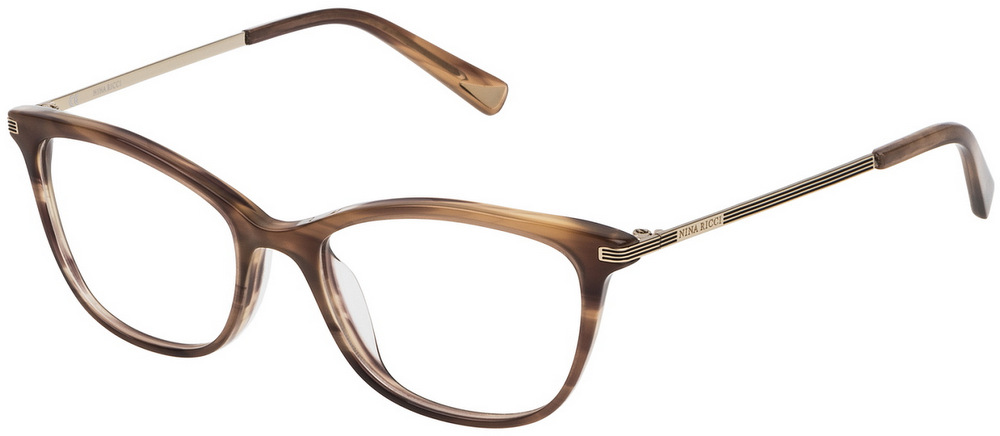
It's an exciting time in the optical world as new styles and technological innovations continue to emerge. Having had a brief look over the history of glasses, it fascinates us to think what's in store in the future. One hundred years from now, will people look back at the Nina Ricci frame above and find it quaint and amusing?! Will we even have prescription glasses in the sense that we know of them now? That's a subject for another article!










